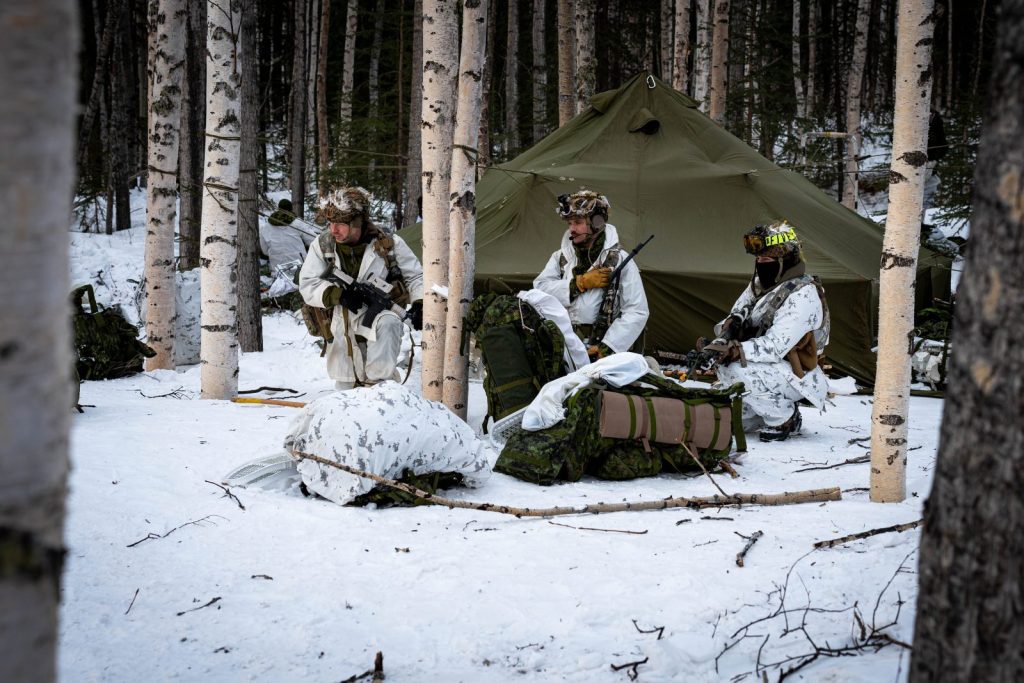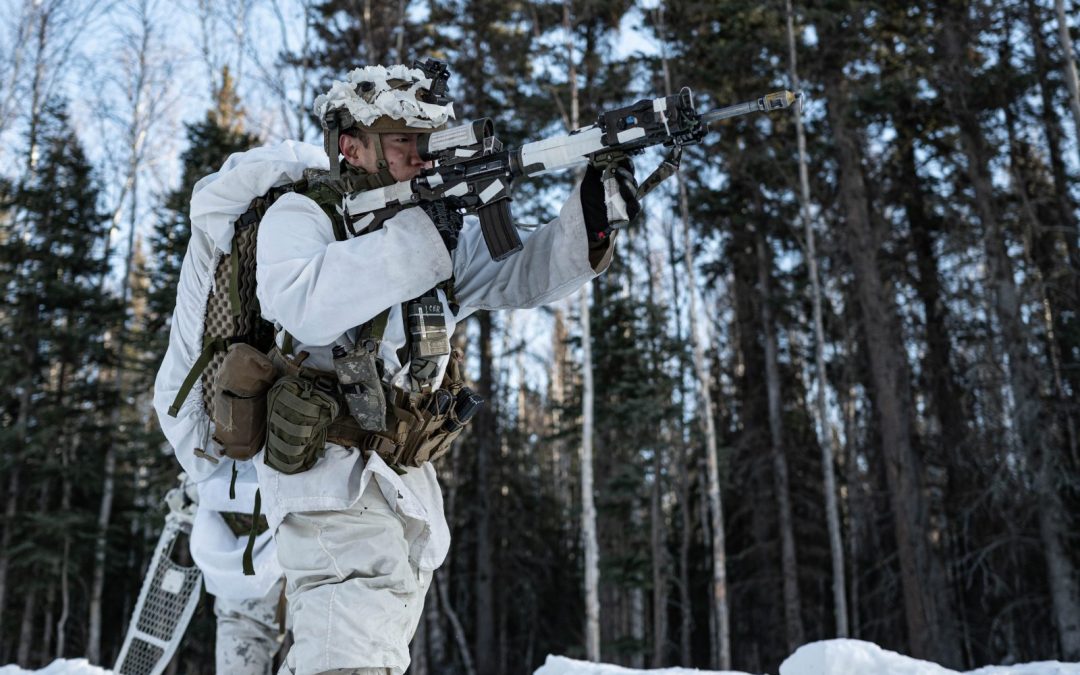by Chris Thatcher
The training area of the Joint Pacific Multinational Readiness Center (JPMRC) is nothing new to Canadian light infantry. Units have for years been training alongside American partners in Fort Wainwright, Alaska. As recently as last April, a company from the 3rd Battalion, Princess Patricia’s Canadian Light Infantry (3 PPCLI) participated in Exercise Arctic Edge with the 11th Airborne Division of the U.S. Army Pacific.
Under the Army’s evolving training plan, however, JPMRC has taken on greater significance. For the first time since the program was revised in 2023, a Canadian light infantry battalion was validated in Alaska for combat operations under Exercise Global Resolve, an annual event that will alternate between the JPMRC and the Joint Readiness Training Center (JRTC) in Louisiana.
The complex training will confirm the battalion ready for deployment as the Army’s Global Response Task Force (GRTF), a high readiness capability able to rapidly project anywhere around the world and conduct a wide variety of missions.
Over 10 days and nights in mid-February, as temperatures fluctuated between plus 6 and minus 20 degrees Celsius, 3 PPCLI completed the first iteration of Ex Global Resolve in Alaska. Attached as a battalion to the 1st Infantry Brigade Combat Team of the 11th Division, based in Fairbanks, 3 PPCLI fought an intense ground battle in the snow, repelling an opposition force (OPFOR) of almost equal strength (in reality, the 2nd Brigade of the 11th Division, based in Anchorage).
JPMRC offers a stark contrast from the hot, muggy and at times swampy training conditions with which many Canadian light infantry members are familiar at the JRTC at Fort Johnson, formerly Fort Polk. With its Arctic and Pacific focus — including training facilities in Hawaii — it also presents a different challenge for battalions training for the sharpest end of warfare.
The 11th Division is itself a work in progress. Officially revised in June 2022, it was rerolled from heavier Stryker brigades to more mobile combat team brigades, better equipped to operate across the Arctic and project into the Pacific with significant combat power.
“Integrating with this division allows us to validate in Arctic environments, but also work with a division that has much more of a Pacific outlook,” a counterbalance to the current NATO focus of the rest of 1 Canadian Mechanized Brigade Group, observed Lieutenant-Colonel Ben Schmidt, commanding officer of 3 PPCLI.
For Ex Global Resolve, the Patricias served as a fully integrated battalion within 1st Brigade, fighting to repel an invading OPFOR of two plus brigades representing an unnamed Pacific superpower that had seized control of Anchorage.

The exercise began with a heavily contested night air assault onto a landing zone near an airfield seized by the OPFOR. 3 PPCLI provided the main effort that involved over 15 aircraft moving more than 800 soldiers in three waves and included three CH-147F Chinooks from 450 Tactical Helicopter Squadron (THS) and six CH-146 Griffons from 408 THS.
Once the airfield was secured, the brigade initiated a series of offensive actions with its manoeuvre battalions to regain territory. It was temporarily forced to take up defensive positions after an OPFOR counterattack, but ultimately pushed forward in an all-out pursuit, a task that involved thousands of soldiers moving in real time over a 20-kilometre area in heavy snow.
“That allowed us to train to a lot of different battle task standards,” said Schmidt, who previously commanded at the platoon and company level in the battalion. “While there was a script for the large-scale combat operations, the enemy had a vote and … we were taken off balance a few times.”
The OPFOR tactics, doctrine, weapons, and other capabilities mirrored those of Pacific superpowers. That provided the 475 members of 3 PPCLI a true test of both its own capabilities, including its networks, and its ability to integrate seamlessly with the American force.
“The 1st Brigade and the 11th Division have been going through a lot of transitions,” he noted. “They only have two infantry battalions in the brigade, so 3 PPCLI was their third infantry manoeuvre battalion. We truly were part of the team, and we were put in as the main effort three or four times. Being able to be a vital part of their combat power and trusted as the main effort — that was a high point.”
As with the Army’s battalions being validated for other planned and contingency operations, dispersal of forces and command-and control (C2) nodes, as well as integrated sustainment were key points for Ex Global Resolve.
In fact, although the manoeuvre of units was a big part of the exercise, “what we were judged on was really C2 — our communications systems, the C4ISR, the ability to move organizations on the battlefield, transmit orders, etc.,” said Schmidt. “The infantry fight is a part of it, but it’s expected that will happen.”
In the lead up, 3 PPCLI worked with the 1st Brigade to ensure its communications systems could “talk.” During the exercise, the U.S. Army conducted operations on the NATO crypto key instead of its normal U.S.-only key for domestic events.
“That is not something that happens inside the U.S. very often,” he noted. “Communication is always a challenge, but we put an emphasis on that so that our radios talked.”
That included the battalion’s Integrated Soldier System suite, a smartphone-like platform and ATAK software with a 163 Harris radio that the unit received last summer. That allowed the battalion to move and share voice and data over a mesh network, relaying critical information among themselves and to and from the brigade without activating VHF channels.
The use of a mesh network meant there were few C2 focal points to defend. “Even if the enemy hits a command post (CP), we do have alternate CPs, and the mesh network does not collapse,” said Schmidt. “You cut one thread on the spider web, but the web is still there.”
One of the objectives, he added, was having “near perfect situational awareness of where your people are at all times, because integration of brigade fires, artillery and other lethal munitions is critical. And if I don’t have a good understanding of where soldiers are, where my flanking units are, I can’t really do my job. All of those were tested.”
In addition, observer controller trainers (OCTs) from the Canadian Manoeuvre Training Centre and JPMRC focused on the brigade’s broader issues of interoperability and sustainment such as compatibility of ammunition and fuel types.
“On a baseline, NATO countries do align for fuel and ammunition, but there were a lot of nuances and detail that needed to be sorted,” said Schmidt, especially when sustainment needed to be maintained in harsh conditions in which “drones are targeting our rear echelon and our supply trucks.”

Uncrewed aerial systems (UAS) played a prominent role throughout the exercise. The OPFOR, in particular, had about 80 quadcopters that were deployed, often in swarms, for intelligence and reconnaissance gathering and for direct attack by dropping nerf bomblets.
“We were extremely conscious of drones, so our command posts are extremely small and well camouflaged,” he stressed. “Everything we had in terms of CPs could be dragged by a snowmobile and set up in the woods. You are in an environment where you can’t hide, so you try to hide in plain sight.”
At one point, a small swarm overflew his partially concealed CP tent in the trees and attacked two vehicles approaching on a nearby road. Schmidt learned afterward that the OPFOR thought the tent, and its minimal electromagnetic signature, was not a high value target.
With JPMRC now a permanent fixture on the training calendar, the relationships formed with the 11th Division will be just as important as the large, challenging scenarios of its training events.
“Exercise Global Resolve ensures the Canadian Army can conduct combat operations in challenging cold weather conditions and in the Arctic, but also serves as an opportunity to strengthen ties with crucial partners in the Indo-Pacific, especially our hosts,” said Army commander Lieutenant-General Joe Paul.
“We are building those relationships,” added Schmidt.
Validated as the Army’s GRTF, 3 PPCLI will spend the next year on standby, ready to respond to any mission to which the government might commit.



Isn’t this just teaching our forces American methods? The same with sending our fast jet training south the USA and to Italy. I know we’ve no money or resources, but outsourcing basic training programmes to other countries cannot be a good thing in the long term.
it’s literally integrating the Canadian military into the US military and creating a dependency on the US for training